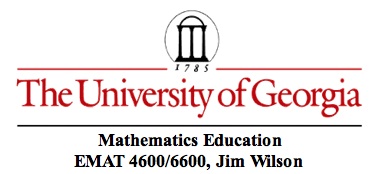

Suppose you have a circle of radius 2R with two medium circles of radius R placed tangent inside of the larger circles, each tangent to the large circle and the other medium circle.
The construction is quite easy and the two discs from these medium sized tangent circles cover half the area of the large circle -- each of the medium circles covers one-fourth of the area of the large circle.
CONSTRUCTION: Show a straightedge and compass construction for two small circles placed so that each is tangent to the large circle AND tangent to each of the two medium circles. Prepare a GSP sketch.
Can you find alternative constructions for these two small circles.
One approach is to construct an isoceles triangle that has its non-base vertex at the center of a small circle.
Another approach is to view the large circle as a circle of inversion. The medium circles would map to parallel lines tangent to the common diameter. Then images of the small circles would be tangent to the large circle (outside) and to the two parallel lines. This would allow us to locate three points on each of the desired small circles and thus be able to construct them.
There surely are others.
What fraction of the area of the large circle is covered by the four discs of the medium and small circles? Estimate. It is clearly more than one half. Two thirds? Three fourths?
Suppose the construction was with SPHERES. Begin with a sphere of radius 2R and inscribe two medium Spheres of radius R. Now FOUR small spheres can be inscribed so that each small sphere is tangent to the large sphere and tangent to each of the medium spheres. Note that these small spheres will NOT be tangent to each other.
What fraction of the volume of the large sphere is contained in the volumes of the SIX inscribed tangent spheres?
Click HERE for a Graphing Calculator file.
Click HERE for a web file.